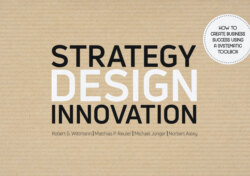Читать книгу Strategy Design Innovation - Robert G. Wittmann - Страница 8
На сайте Литреса книга снята с продажи.
ОглавлениеChapter 2
STRATEGY DESIGN INNOVATION – INTRODUCING THE ENTIRE MODEL
INTRODUCTION TO CHAPTER 2
In chapter 2 we will introduce the entire model of Strategy Design Innovation providing the basic definitions of
— Strategy Design,
— the Strategy Design Toolbox,
— Strategy Design Modelling and
— Strategy Design Innovation.
2.1 Strategy Design
Here is the definition of Strategy Design:
A STRATEGY DESIGN IS
1. a consistent set of measures
2. aligning a company and its environment,
3. with the overriding goal of creating value for all stakeholders
4. in a balanced way.
❶ ‘Set’ means more than just one measure and ‘consistent’ means that all measures must be aligned in a common strategic direction.
➋ ‘aligning a company and its environment’ according to Michael Porter‘s (1986) definition of strategy.
➌ It is our conviction that the purpose of any strategy must be: to create value for all stakeholders.
➍ The term ‘balanced’ applies to points 1, 2 and 3. It means that the different parts should be held m a relatively acceptable equilibrium.
We use the word ‘Design’ to underline that the process of creating a strategy is based on the methodology of Design Thinking.
The concept of Strategy Design replaces the traditional concept of a Business Plan or a Business Strategy.
2.2 Strategy Design Toolbox
Here is the definition of the Strategy Design Toolbox
The Strategy Design Toolbox is a framework
— of seven perspectives
— with four methods each
— allowing to ask strategic questions and to find answers.
Table 2.1 The Strategy Design Toolbox and its two platforms. ▼
As shown in Table 2.1, the ‘seven perspectives’ give a holistic overview of all the relevant aspects of Strategy Design. This is what we call the ‘Overview Platform’. It helps to find orientation and to connect the answers in a consistent way.
The four strategic questions per perspective and the associated methods allow to find answers. This is what we call the ‘Detail Platform’. It helps to analyze problems and to create solutions for Strategy Design.
2.3 Strategy Design Modelling
Here is the definition of Strategy Design Modelling:
Strategy Design Modelling is the process of applying the Strategy Design Toolbox to concrete strategic cases.
Strategy Design Modelling can be done using three different approaches:
❶ A linear process allows working from top to bottom and from left to right of the Strategy Design Toolbox. Example: If you intend to analyze, develop and validate a new business idea, it makes sense to opt for the linear approach.
➋ A flexible and networked process allows jumping from perspective to perspective and from tool to tool.
Example: If you want to analyze an existing business and validate it reacting e.g. to critical incidents in the environments,it makes sense to opt for the flexible and networked approach.
➌ Both approaches are combined in the ‘pyramid approach’outlined in chapter 4.1.
Table 2.2 The Strategy Design Toolbox and the two approaches for Strategy Design Modelling. ►
2.4 Strategy Design Innovation
Here is the definition of Strategy Design Innovation:
Strategy Design Innovation is
— a continuous strategic adaption and improvement process,
— pushing a Strategy Design to the next higher level.
Strategy Design Innovation takes into account the experience
— both from the current implementation of a given Strategy Design
— and from new developments and influences
— so that innovation takes place whenever this is required or reasonable – not just when a revision cycle is over (e.g. one fiscal year).
The result will be that
— the Strategy Design never grows old or obsolete
— innovation will not lag behind, because it is now part of the strategic process.
